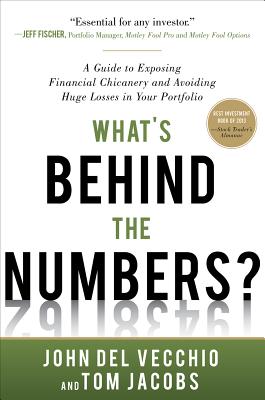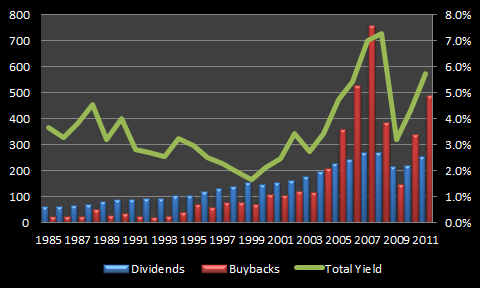Today I'd like to highlight one great lesson from each of these books and show how we can immediately apply them to our research processes.
What's Behind the Numbers?: A Guide to Exposing Financial Chicanery and Avoiding Huge in Your Portfolio (Amazon) by John Del Vecchio and +Tom Jacobs
 John and Tom are former colleagues of mine from +The Motley Fool, and being familiar with the quality of their work, I went in with very high expectations and still came away extremely impressed. Their book provides a thorough overview of some important yet often overlooked topics including earnings quality analysis, short-selling, deep value investing, long/short portfolio construction, and technical analysis.
John and Tom are former colleagues of mine from +The Motley Fool, and being familiar with the quality of their work, I went in with very high expectations and still came away extremely impressed. Their book provides a thorough overview of some important yet often overlooked topics including earnings quality analysis, short-selling, deep value investing, long/short portfolio construction, and technical analysis.The book provides dozens of great formulas and tips, but John and Tom emphasize the importance of one particular metric:
"Here are some of the factors that we analyze to determine the quality of the company's revenue. At the top is a metric you should have burned into your memory: days sales outstanding."
DSO = 91.25 x (Accounts Receivable / Quarterly Revenue)
This formula measures the number of days it takes the company to collect revenue after it makes a sale. If that figure is trending higher, for instance, it could be a sign that the company is offering more liberal payment terms to its customers in hopes of booking more sales now. A higher DSO alone doesn't necessarily mean something serious is afoot, but it can be a tip-off to look more closely at earnings quality.
To use a real-world example, let's take a look at the quarterly revenue and receivables of Sun Hydraulics* (SNHY)
As we can see, SNHY's DSO has been pretty steady between 32 and 39 days over the past ten quarters, and there hasn't been any substantial increase in any year-over-year figure. If DSO had been trending upward -- to say, 45 or 50 days -- it could be a sign that management had been "stuffing the channel" to make short-term results look better and could come at the expense of longer-term results.
To use a real-world example, let's take a look at the quarterly revenue and receivables of Sun Hydraulics* (SNHY)
| Source: Company Filings, in thousands of $ except DSO |
The Success Equation: Untangling Skill and Luck in Business, Sports, and Investing (Amazon) by Michael Mauboussin
While this book is not completely about investing, Mauboussin is the Chief Investment Strategist at Legg Mason and an adjunct professor of finance at Columbia, so there is naturally quite a bit of investing discussed along with some great discussion about the roles that skill and luck play in our favorite sports and games.
"Luck may or may not smile on us, but if we stick to a good process for making decisions, then we can learn to accept the outcomes of our decisions with equanimity."
One way we might improve our investing process is to create checklists and review them before making buy and sell decisions, particularly in stressful situations like the one illustrated in this example from the book:
"A friend at a prominent hedge fund told me that his firm has developed a checklist for responding when a company suddenly announces bad news. While the stocks of those companies always go down at first, sometimes the drop is nothing more than an opportunity to buy more shares. At other times, it's best to sell the position. The checklist helps the employees keep their heads cool as they decide which is the better decision."
Reading this particular paragraph inspired me to write the post What to Do When a Sell-Off Strikes Your Stock. To review, my "bad news" checklist is:
- It's important to stay as calm as possible. Breathe and scan.
- Rather than read or watch news reports, which are typically sensationalized, go straight to the source. Read the company's press release and any associated presentation materials.
- After you've gathered the facts, develop your own take on the event.
- Revisit your original investment thesis, paying close attention to how the new information might impact the company's longer-term competitive position.
- Ask yourself, "Does this development fundamentally alter my thesis?" If so, consider selling and don't anchor into the price you originally paid for the stock.
- Consider buying more if your thesis remains intact, bearing in mind your current exposure to the investment and how the new share price compares with your fair value estimate.
- Remember that doing nothing is doing something. As such, know why you're deciding not to take an action.
Consider putting your own buy or sell checklist together. I think you'll find it to be a helpful exercise.
Deals from Hell: M&A Lessons that Rise Above the Ashes (Amazon) by Robert F Bruner
 Many individual investors have mixed feelings about M&A, particularly if its your company doing the acquiring. Misguided M&A decisions can destroy value, muddle financial statements, and can alter your original investment thesis. In short, they can be a real pain in the neck.
Many individual investors have mixed feelings about M&A, particularly if its your company doing the acquiring. Misguided M&A decisions can destroy value, muddle financial statements, and can alter your original investment thesis. In short, they can be a real pain in the neck.Bruner, who is the Dean of the Darden School of Business at the University of Virginia, makes the point early on, however, that:
"M&A failures amount to a small percentage of the total volume of M&A activity. Investments through acquisition appear to pay about as well as other forms of corporate investment. The mass of research suggests that on average, buyers earn a reasonable return relative to their risks."
Fair enough, but investors should still approach significant M&A deals with skepticism until proven otherwise. And, to Bruner's credit, this book does equip you with a good framework for evaluating M&A deals, featuring case studies of some of the worst deals in modern financial history -- i.e. Enron/Dynegy, Quaker Oats/Snapple, AOL/Time Warner, etc.
Bruner's list of common red flags includes:
- The business and/or the deal was complicated -- An acquired company that is difficult to understand or has a complex business model will likely be a difficult one to integrate.
- Flexibility was at a minimum -- A company that overpays for a deal and/or over-leverages its balance sheet to make the deal happen has little room for error.
- The deal elevated risk exposure of the new firm -- The additional risk could come from a number of sources (legal issues, lower credit ratings, too much leverage, declining end-markets, etc.).
- Decision-making process was biased -- An example here would be an overconfident management team that was willing to pay anything to make the deal happen.
- Business was not as usual -- The deal creates a significant departure from the company's routine and/or expertise.
- Cultural differences -- If two companies with very different cultures (i.e. regional customs, level of bureaucracy, etc.) merge, it could lead to the departure of key individuals at the acquired company.
To help us identify a poor M&A decision, Bruner provides this helpful summary of good and bad M&A traits:
Return to buyers likely higher if… | Return to buyers likely lower if… |
Strategic motivation | Opportunistic motivation |
Value acquiring | Momentum growth/glamour acquiring |
Focused/related acquiring | Lack of focus/unrelated diversification |
Credible synergies | Incredible synergies |
To use excess cash profitably | Just to use excess cash |
Negotiated purchases of private firms | Auctions of public firms |
Cross borders for special advantage | Cross boarders naively |
Go hostile | Negotiate with resistant target |
Buy during cold M&A markets | Buy during hot M&A markets |
Pay with cash | Pay with stock |
High tax benefits to buyer | Low tax benefits to buyer |
Finance with debt judiciously | Over-lever |
Stage the payments (earnouts) | Pay fully up-front |
Merger of equals | Not a merger of equals |
Managers have significant stake | Managers have low or no stake |
Shareholder-oriented management | Entrenched management |
Active investors | Passive investors |
If your company has just announced a major acquisition, turn to this table and see how many boxes fit the left column versus the right column. The more check marks on the right hand column, the more you should be skeptical of the deal.
Merry Christmas and Happy New Year!
As always, thanks for reading.
Todd
@toddwenning on Twitter
*I own shares of SNHY
















